
Gnetophyta is a division of plants, grouped within the gymnosperms, that consists of some 70 species across the three relict genera: Gnetum, Welwitschia, and Ephedra. The earliest unambiguous records of the group date to the Jurassic, and they achieved their highest diversity during the Early Cretaceous. The primary difference between gnetophytes and other gymnosperms is the presence of vessel elements, a system of small tubes (xylem) that transport water within the plant, similar to those found in flowering plants. Because of this, gnetophytes were once thought to be the closest gymnosperm relatives to flowering plants, but more recent molecular studies have brought this hypothesis into question, with many recent phylogenies finding them to be nested within the conifers.
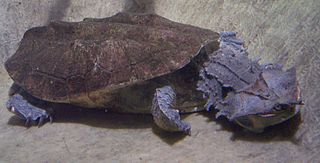
Chelidae is one of three living families of the turtle suborder Pleurodira, and are commonly called Austro-South American side-neck turtles. The family is distributed in Australia, New Guinea, parts of Indonesia, and throughout most of South America. It is a large family of turtles with a significant fossil history dating back to the Cretaceous. The family is entirely Gondwanan in origin, with no members found outside Gondwana, either in the present day or as a fossil.
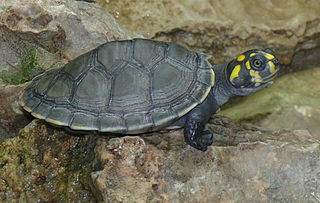
Podocnemididae is a family of pleurodire (side-necked) turtles, once widely distributed. Most of its 41 genera and 57 species are now extinct. Seven of its eight surviving species are native to South America: the genus Peltocephalus, with two species, only one of which is extant ; and the genus Podocnemis, with six living species of South American side-necked river turtles and four extinct. There is also one genus native to Madagascar: Erymnochelys, the Madagascan big-headed turtle, whose single species E. madagascariensis.
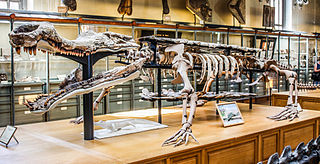
Sarcosuchus is an extinct genus of crocodyliform and distant relative of living crocodilians that lived during the Early Cretaceous, from the late Hauterivian to the early Albian, 133 to 112 million years ago of what is now Africa and South America. The genus name comes from the Greek σάρξ (sarx) meaning flesh and σοῦχος (souchus) meaning crocodile. It was one of the largest pseudosuchians, with the largest specimen of S. imperator reaching approximately 9–9.5 metres (29.5–31.2 ft) long and weighing up to 3.45–4.3 metric tons. It is known from two species; S. imperator from the early Albian Elrhaz Formation of Niger, and S. hartti from the Late Hauterivian of northeastern Brazil. Other material is known from Morocco and Tunisia and possibly Libya and Mali.

Suchomimus is a genus of spinosaur dinosaur that lived between 125 and 112 million years ago in what is now Niger, north Africa, during the Aptian to early Albian stages of the Early Cretaceous period. It was named and described by paleontologist Paul Sereno and colleagues in 1998, based on a partial skeleton from the Elrhaz Formation. Suchomimus's long and shallow skull, similar to that of a crocodile, earns it its generic name, while the specific name Suchomimus tenerensis alludes to the locality of its first remains, the Ténéré Dese.

Ouranosaurus is a genus of herbivorous basal hadrosauriform dinosaur that lived during the Aptian stage of the Early Cretaceous of modern-day Niger and Cameroon. Ouranosaurus measured about 7–8.3 metres (23–27 ft) long and weighed 2.2 metric tons. Two rather complete fossils were found in the Elrhaz Formation, Gadoufaoua deposits, Agadez, Niger, in 1965 and 1970, with a third indeterminate specimen known from the Koum Formation of Cameroon. The animal was named in 1976 by French paleontologist Philippe Taquet; the type species being Ouranosaurus nigeriensis. The generic name is a combination of ourane, a word with multiple meanings, and sauros, the Greek word for lizard. The specific epithet nigeriensis alludes to Niger, its country of discovery. And so, Ouranosaurus nigeriensis could be interpreted as "brave lizard originating from Niger".
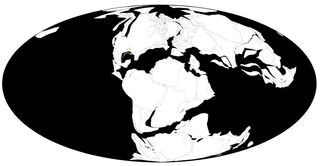
The Aptian is an age in the geologic timescale or a stage in the stratigraphic column. It is a subdivision of the Early or Lower Cretaceous Epoch or Series and encompasses the time from 121.4 ± 1.0 Ma to 113.0 ± 1.0 Ma, approximately. The Aptian succeeds the Barremian and precedes the Albian, all part of the Lower/Early Cretaceous.

Cristatusaurus is a genus of theropod dinosaur that lived during the Early Cretaceous Period of what is now Niger, 112 million years ago. It was a baryonychine member of the Spinosauridae, a group of large bipedal carnivores with well-built forelimbs and elongated, crocodile-like skulls. The type species Cristatusaurus lapparenti was named in 1998 by scientists Philippe Taquet and Dale Russell, on the basis of jaw bones and some vertebrae. Two claw fossils were also later assigned to Cristatusaurus. The animal's generic name, which means "crested reptile", alludes to a sagittal crest on top of its snout; while the specific name is in honor of the French paleontologist Albert-Félix de Lapparent. Cristatusaurus is known from the Albian to Aptian Elrhaz Formation, where it would have coexisted with sauropod and iguanodontian dinosaurs, other theropods, and various crocodylomorphs.

Lurdusaurus is a genus of massive and unusually shaped iguanodont dinosaur from the Elrhaz Formation in Niger. It contains one species, L. arenatus. The formation dates to the Early Cretaceous, roughly 112 million years ago. Lurdusaurus has a highly atypical body plan for an iguanodont, with a small skull, long neck, rotund torso, and powerful forelimbs and claws, somewhat reminiscent of a ground sloth. Its metacarpals are fused and reinforced into a large block, and the thumb spike is remarkably enormous. These would have allowed the hand to have functioned almost like a ball-and-chain flail. Lurdusaurus is estimated to have been 7–9 m (23–30 ft) long and 2 m high when on all-fours, but its stomach would have been only 70 cm off the ground. It may have weighed 2.5–5.5 t, conspicuously heavy for an iguanodontid this size.

The Pleurodira are one of the two living suborders of turtles, the other being the Cryptodira. The division between these two suborders represents a very deep evolutionary divide between two very different types of turtles. The physical differences between them, although anatomical and largely internal, are nonetheless significant, and the zoogeographic implications of them are substantial. The Pleurodira are known more commonly as the side-necked turtles and the name Pleurodira quite literally translates to side neck, whereas the Cryptodira are known as hidden-necked turtles. The Pleurodira turtles are currently restricted to freshwater habitats in the Southern Hemisphere, largely to Australia, South America, and Africa. Within the Pleurodira, three living families are represented: Chelidae, also known as the Austro-South American side-necked turtles, the Pelomedusidae, also known as the African mud terrapins, and the Podocnemididae, also known as the American side-neck river turtles. However, they were cosmopolitan clade during the Cretaceous and most of the Cenozoic, and even occurred in marine environments around the world.

Bothremydidae is an extinct family of side-necked turtles (Pleurodira) known from the Cretaceous and Cenozoic. They are closely related to Podocnemididae, and are amongst the most widely distributed pleurodire groups, with their fossils having been found in Africa, India, the Middle East, Europe, North America and South America. Bothremydids were aquatic turtles with a high morphological diversity, indicative of generalist, molluscivorous, piscivorous and possibly herbivorous grazing diets, with some probably capable of suction feeding. Unlike modern pleurodires, which are exclusively freshwater, bothremydids inhabited freshwater, marine and coastal environments. Their marine habits allowed bothremydids to disperse across oceanic barriers into Europe and North America during the early Late Cretaceous (Cenomanian). The youngest records of the group are indeterminate remains from Saudi Arabia and Oman, dating to the Miocene.

Kryptops is a genus of abelisaurid theropod dinosaur from the Early Cretaceous of Niger. It is known from a partial skeleton found at the Gadoufaoua locality in the western Ténéré Desert, in rocks of the Aptian–Albian-age Elrhaz Formation. This dinosaur was described by paleontologists Paul Sereno and Stephen Brusatte in 2008. The genus name means "covered face", in reference to evidence that the face bore a tightly adhering covering. The type species is K. palaios, which means "old".
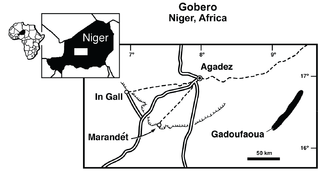
The Elrhaz Formation is a geological formation in Niger, West Africa.

Elrhazosaurus is a genus of basal iguanodontian dinosaur, known from isolated bones found in Early Cretaceous rocks of Niger. These bones were initially thought to belong to a species of the related dryosaurid Valdosaurus, but have since been reclassified.
Sokatra is an extinct genus of pleurodiran turtle, known from the Cretaceous (Maastrichtian) Maevarano Formation of Madagascar. It belongs to the family Sahonachelyidae.

Paleontology or palaeontology is the study of prehistoric life forms on Earth through the examination of plant and animal fossils. This includes the study of body fossils, tracks (ichnites), burrows, cast-off parts, fossilised feces (coprolites), palynomorphs and chemical residues. Because humans have encountered fossils for millennia, paleontology has a long history both before and after becoming formalized as a science. This article records significant discoveries and events related to paleontology that occurred or were published in the year 2013.
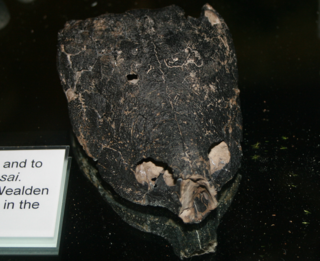
The Helochelydridae are an extinct family of stem-turtles known from fossils found in North America and Europe spanning the Early to Late Cretaceous.
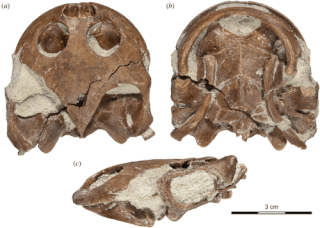
Sahonachelyidae is an extinct family of pelomedusoid turtles from the Late Cretaceous (Maastrichtian) Maevarano Formation of Madagascar. The clade was recognized in 2021 by Joyce et al., and contains two genera: Sahonachelys and Sokatra. The clade is characterized by the presence of a reduced contribution of the maxilla to the floor of the orbit, and, the presence of a distinct posterior process of the maxilla. The clade went extinct at the end of the Cretaceous period during the K-Pg extinction event.

Amabilis uchoensis is a species of prehistoric pleurodiran turtle from the Late Cretaceous of South America. It is the only species in the genus Amabilis.
Acleistochelys is an extinct genus of large, bothremydid pleurodiran turtle known from Paleocene deposits in the Teberemt Formation of Mali. The type species, A. maliensis, was named for the country in which it was found. The holotype specimen consists of a nearly complete skull, shell fragments, pelvic fragments, and a cervical vertebra. It is most closely related to another Paleocene Malian side-necked turtle, Azabbaremys.


















